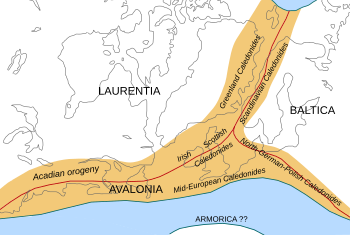
The Scandinavian Caledonides are the vestiges of an ancient, today deeply eroded orogenic belt formed during the Silurian–Devonian continental collision of Baltica and Laurentia, which is referred to as the Scandian phase of the Caledonian orogeny.[11] The size of the Scandinavian Caledonides at the time of their formation can be compared with the size of the Himalayas.[12] The area east of the Scandinavian Caledonides, including parts of Finland, developed into a foreland basin where old rocks and surfaces were covered by sediments.[13] Today, the Scandinavian Caledonides underlay most of the western and northern Scandinavian Peninsula,[14][15] whereas other parts of the Caledonides can be traced into West and Central Europe as well as parts of Greenland[16] and eastern North America.
- ^ a b c Domeier, Mathew (2016). "A plate tectonic scenario for the Iapetus and Rheic oceans". Gondwana Research. 36: 275–295. Bibcode:2016GondR..36..275D. doi:10.1016/j.gr.2015.08.003. ISSN 1342-937X.
- ^ Torsvik, Trond; Smethurst, M.; Meert, J.; Van der Voo, Rob; McKerrow, W.; Brasier, M.; Sturt, Brian A.; Walderhaug, H. (1996). "Continental break-up and collision in the Neoproterozoic and Palaeozoic — A tale of Baltica and Laurentia". Earth-Science Reviews. 40 (3–4): 229–258. Bibcode:1996ESRv...40..229T. doi:10.1016/0012-8252(96)00008-6. ISSN 0012-8252.
- ^ Stampfli, G.M; Borel, G.D (2002). "A plate tectonic model for the Paleozoic and Mesozoic constrained by dynamic plate boundaries and restored synthetic oceanic isochrons". Earth and Planetary Science Letters. 196 (1–2): 17–33. Bibcode:2002E&PSL.196...17S. doi:10.1016/s0012-821x(01)00588-x. ISSN 0012-821X.
- ^ Matte, P. (2001). "The Variscan collage and orogeny (480-290 Ma) and the tectonic definition of the Armorica microplate: a review". Terra Nova. 13 (2): 122–128. Bibcode:2001TeNov..13..122M. doi:10.1046/j.1365-3121.2001.00327.x. ISSN 0954-4879. S2CID 129727506.
- ^ Ziegler, P. A. (1990). Geological Atlas of Western and Central Europe. Shell Internationale Petroleum Maatschappij BV/Geological Society of London.
- ^ Torsvik, Trond H.; Rehnström, Emma F. (2003). "The Tornquist Sea and Baltica–Avalonia docking". Tectonophysics. 362 (1–4): 67–82. Bibcode:2003Tectp.362...67T. doi:10.1016/s0040-1951(02)00631-5. ISSN 0040-1951.
- ^ Torsvik, Trond H.; Van der Voo, Rob; Preeden, Ulla; Mac Niocaill, Conall; Steinberger, Bernhard; Doubrovine, Pavel V.; van Hinsbergen, Douwe J.J.; Domeier, Mathew; Gaina, Carmen (2012). "Phanerozoic polar wander, palaeogeography and dynamics". Earth-Science Reviews. 114 (3–4): 325–368. Bibcode:2012ESRv..114..325T. doi:10.1016/j.earscirev.2012.06.007. hdl:10852/62957. ISSN 0012-8252.
- ^ Mosar, Jon; Eide, Elizabeth A.; Osmundsen, Per Terje; Sommaruga, Anna; Torsvik, Trond H. (2002). "Greenland-Norway separation: A geodynamic model for the North Atlantic". Norwegian Journal of Geology. 82: 281–298.
- ^ Gaina, Carmen; Gernigon, L.; Ball, P. (2009). "Palaeocene–Recent plate boundaries in the NE Atlantic and the formation of the Jan Mayen microcontinent". Journal of the Geological Society. 166 (4): 601–616. Bibcode:2009JGSoc.166..601G. doi:10.1144/0016-76492008-112. ISSN 0016-7649. S2CID 128700588.
- ^ Seton, Maria; Müller, R.D.; Zahirovic, S.; Gaina, Carmen; Torsvik, Trond H.; Shephard, Grace; Talsma, A.; Gurnis, M.; Turner, M. (2012). "Global continental and ocean basin reconstructions since 200 Ma". Earth-Science Reviews. 113 (3–4): 212–270. Bibcode:2012ESRv..113..212S. doi:10.1016/j.earscirev.2012.03.002. ISSN 0012-8252.
- ^ Corfu, F.; Andersen, T. B.; Gasser, D. (2014). "The Scandinavian Caledonides: main features, conceptual advances and critical questions". Geological Society, London, Special Publications. 390 (1): 9–43. Bibcode:2014GSLSP.390....9C. doi:10.1144/sp390.25. ISSN 0305-8719. S2CID 128630362.
- ^ Labrousse, Loïc; Hetényi, György; Raimbourg, Hugues; Jolivet, Laurent; Andersen, Torgeir B. (2010). "Initiation of crustal-scale thrusts triggered by metamorphic reactions at depth: Insights from a comparison between the Himalayas and Scandinavian Caledonides" (PDF). Tectonics. 29 (5): n/a. Bibcode:2010Tecto..29.5002L. doi:10.1029/2009tc002602. ISSN 0278-7407.
- ^ Murrell, G.R.; Andriessen, P.A.M. (2004). "Unravelling a long-term multi-event thermal record in the cratonic interior of southern Finland through apatite fission track thermochronology". Physics and Chemistry of the Earth, Parts A/B/C. 29 (10): 695–706. Bibcode:2004PCE....29..695M. doi:10.1016/j.pce.2004.03.007.
- ^ Green, Paul F.; Lidmar-Bergström, Karna; Japsen, Peter; Bonow, Johan M.; Chalmers, James A. (2013). "Stratigraphic landscape analysis, thermochronology and the episodic development of elevated, passive continental margins". Geological Survey of Denmark and Greenland Bulletin. 30: 18. doi:10.34194/geusb.v30.4673. Retrieved 30 April 2015.
- ^ Gabrielsen, Roy H.; Faleide, Jan Inge; Pascal, Christophe; Braathen, Alvar; Nystuen, Johan Petter; Etzelmuller, Bernd; O'Donnel, Sejal (2010). "Latest Caledonian to Present tectonomorphological development of southern Norway". Marine and Petroleum Geology. 27 (3): 709–723. Bibcode:2010MarPG..27..709G. doi:10.1016/j.marpetgeo.2009.06.004.
- ^ Haller, J. (1985). "The East Greenland Caledonides—reviewed". The Caledonide Orogen—Scandinavia and Related Areas: 1031–1046.
